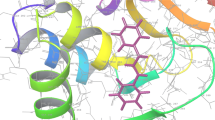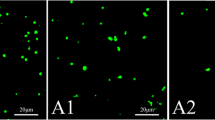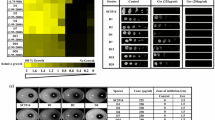Abstract
Candida albicans is one of the most virulent and opportunistic fungal strains. In the present scenario, majority metabolic imbalances and unsuccessful treatments of some severe diseases including cancer, diabetes, HIV, psoriasis are because of invasive Candida emergence. Being a beneficial integral part of human biome, its elimination is not possible. The major pathogenicity characteristics in Candida involve hyphal growth, biofilm formation, HSP90 down regulation and genetic modifications. Ras1-pka pathway initiated by HSP90 down regulation is important for hyphal growth and has been focused in the present study. The principle transcriptional factors that induce hyphal growth causing invasiveness and virulence through this pathway have been identified as Tec1 and Rfg1. In the present study, taxifolin, a naturally occurring polyphenol, has been identified as inhibitor for both the transcriptional factors in parallel.








Similar content being viewed by others
References
Bakri MM, Hussaini HM, Holmes AM, Cannon RD, Rich AM. Revisiting the association between candida infection and carcinoma, particularly oral squamous cell carcinoma. J Oral Microbiol. 2010;2:5780.
Gordon R, Pyne S, Bulyk ML. Identification of cell-cycle regulated, putative hyphal genes in Candida albicans. Pac Symp Biocomput. 2012: 299–310.
Dalle F, et al. Cellular interactions of Candida albicans with human oral epithelial cells and enterocytes. Cell Microbiol. 2010;12:248–71.
Noble SM, Johnson AD. Genetics of Candida albicans, and a diploid human fungal pathogen. Annu Rev Genet. 2007;41:193–211.
Shapiro RS, Uppuluri P, Zaas AK, et al. Hsp90 orchestrates temperature-dependent Candida albicans morphogenesis via Ras1-PKA signaling. Curr Biol CB. 2009;19(8):621–9.
Mishra S, Kumar A, Varadwaj PK, et al. Structure-based drug designing and simulation studies for finding novel inhibitors of heat shock protein (HSP70) as suppressors for psoriasis. Interdiscip Sci Comput Life Sci. 2016;. doi:10.1007/s12539-016-0188-1.
Mishra S, Misra K. In-silico based designing of inhibitors against the virulence and filamentation of Candida albicans, a common human pathogen. In: International conference on bioinformatics and systems biology (BSB); 2016. p. 10.
Braun BR, Johnson AD. Control of filament formation in Candida albicans by the transcriptional repressor TUP1. Science. 1997;277:105–9.
Kadosh D, Johnson AD. Induction of the Candida albicans filamentous growth program by relief of transcriptional repression: a genome-wide analysis. Mol Biol Cell. 2005;16:2903–12.
Braun BR, Kadosh D, Johnson AD. NRG1, a repressor of filamentous growth in C. albicans, is down-regulated during filament induction. EMBO J. 2001;20:4753–61.
Kohler T, Wesche S, Taheri N, Braus GH, Mosch HU. Identification of novel activation mechanisms for FLO11 regulation in Saccharomyces cerevisiae. Eukaryot Cell. 2002;1:673–86.
Mayer FL, Wilson D, Hube B. Candida albicans pathogenicity mechanisms. Virulence. 2013;4(2):119–28.
Berman J, Sudbery PE. Candida albicans: a molecular revolution built on lessons from budding yeast. Nat Rev Genet. 2002;3(12):918–30.
Biswas S, Dijck PV, Datta A. Environmental sensing and signal transduction pathways regulating morpho-pathogenic determinants of Candida albicans. Microbiol Mol Biol Rev. 2007;71:348–76.
Harris SD, Momany M. Polarity in filamentous fungi: moving beyond the yeast paradigm. Fungal Genet Biol. 2004;41:391–400.
Jessica LR, Kaufman PD. Chromatin-mediated Candida albicans virulence. Biochim Biophys Acta. 2012;1819:349–55.
Arnold K, Bordoli L, Kopp J, Schwede T. The SWISS-MODEL workspace: a web-based environment for protein structure homology modelling. Bioinformatics. 2006;22:195–201.
Sastry GM, Adzhigirey M, Day T, Annabhimoju R, Sherman W. Protein and ligand preparation: parameters, protocols, and influence on virtual screening enrichments. J Comput Aid Mol Des. 2013;27(3):221–34.
Ramachandran GN, Ramakrishnan C, Sasisekharan V. Stereochemistry of polypeptide chain configurations. J Mol Biol. 1963;7:95–9.
Furnham N, Andrew S, Dimitri Y, Chirgadze PI, Depristo WM, Blundell TL. Knowledge-based real-space exporations for low-resolution structure determination. Structure. 2006;14:1313–20.
Halgren T. New method for fast and accurate binding-site identification and analysis. Chem Biol Drug Des. 2007;69:146–8.
Irwin JJ, Shoichet BK. ZINC – A Free Database of Commercially Available Compounds for Virtual Screening. J Chem Inf Model. 2005;45(1):177–182.
Beard H, Cholleti A, Pearlman D, Sherman W, Loving KA. Applying physics-based scoring to calculate free energies of binding for single amino acid mutations in protein-protein complexes. PLoS ONE. 2013;8(12):82849.
Friesner RA, Murphy RB, Repasky MP, Frye LL, Greenwood JR, Halgren TA, Sanschagrin PC, Mainz DT. Extra precision glide: docking and scoring incorporating a model of hydrophobic enclosure for protein-ligand complexes. J Med Chem. 2006;49:6177–96.
Watts KS, Dalal P, Murphy RB, Sherman W, Friesner RA, Shelley JC. ConfGen: a conformational search method for efficient generation of bioactive conformers. J Chem Inf Model. 2010;50:534–46.
Zhu K, Borrelli KW, Greenwood JR, Day T, Abel R, Farid RS, Harder E. Docking covalent inhibitors: a parameter free approach to pose prediction and scoring. J Chem Inf Model. 2014;54:1932–40.
Author information
Authors and Affiliations
Corresponding author
Rights and permissions
About this article
Cite this article
Mishra, S., Singh, S. & Misra, K. Restraining Pathogenicity in Candida albicans by Taxifolin as an Inhibitor of Ras1-pka Pathway. Mycopathologia 182, 953–965 (2017). https://doi.org/10.1007/s11046-017-0170-4
Received:
Accepted:
Published:
Issue Date:
DOI: https://doi.org/10.1007/s11046-017-0170-4




